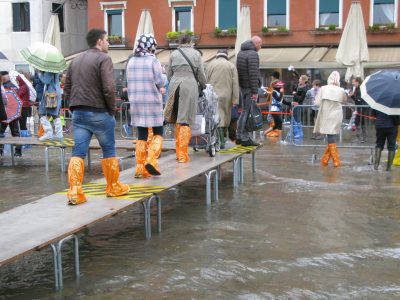Collaborative Science and Coastal Adaptation

In July an important paper of international relevance was published in Frontiers and Marine Science titled “Collaborative science to enhance coastal resilience and adaptation”. The lead authors were C. Reid Nichols and Don Wright along with 11 others including Scott Bainbridge from AIMS in Townsville. Wright and Reid Nichols are also editors of the new book “Tomorrow’s Coasts: Complex and Impermanent” (2019, Springer).
The paper is predicated on the increasing need for communities and decision-makers to understand and respond to impacts from natural and anthropogenic induced coastal hazards. This means that coastal communities are increasingly at risk not just from short-term extreme events, but under changing long-term conditions seen as embracing sea level rise, increasing storm intensity and “consequent severe compound flooding events”.
Why do I think this paper is important? It adds to the contemporary debate on the need for higher levels of collaboration of those whose realm of interest is coastal policy, planning and management. We know that this is not easily achieved given the silos that exist inside and outside of government. Of interest are recent comments by the Chair of the Australian Productivity Commission, Michael Brennan. He highlights how economists must change their thinking in order to improve policymaking by working more with experts in other fields rather than supplanting them. This requires “close interdisciplinary cooperation”.
One of the big challenges in future is managing the proliferation of data from many disciplinary sources and how that relates to improved capacity to model complex systems, including the potential for applying Artificial Intelligence. The Frontiers and Marine Science paper addresses such a system, viz coasts at risk, through: (1) an examination of the link between observations and modelling; (2) how to handle “big data” especially for urban coasts; and (3) community social vulnerability where changing climatic conditions are having impacts now and more so in the future.
Delving into this paper at times is a struggle. I sometimes despair at proliferation of terms like vulnerability, risk, resilience, sensitivity and susceptibility, where their use is not always clear. Many issues are presented in the paper and at times it takes several reads to appreciate the details. But the main thrust is never far away in what the authors refer to as a “White Paper” that “outlines the rationale, synthesizes recent literature and summarizes some data-driven approaches to coastal resilience”.
One of their key points is that any assessment of coastal resilience must recognise that “coastal vulnerabilities are locally and regionally specific and prioritization of the most important observational data and model predictions must rely heavily on input from local and regional communities and decision makers”. This leads the authors to argue for the use of “agile and spatially distributed response capabilities that will assist operational organizations in predicting, preparing for and mitigating potential community-wide disasters”. To this end the paper notes the importance of local approaches in different toolkits that are available on interactive sites, such as CCVATCH. A spatial example is provided for the area around New York City and Newark, New Jersey. “Surging Seas” risk zones from the Climate Central web site are shown here. Zones of low, medium and high predicted social vulnerability are indicated for a 3m storm surge or sea level rise. In this case social vulnerability includes measures of population, ethnicity, income, property and landmarks. This is an example of how data and models have been used and how new technologies can be applied to improve resilience and develop adaptation strategies. At an international scale, reference is made to the French system for data management and dissemination which covers global observing networks and tools for data discovery and visualization as well encouraging sharing of information.
But the question arises as to how all these developments in observing systems and predictive modelling can be made useful to coastal communities seeking to mitigate impacts of extreme events and adapt to long-term coastal degradation. The authors advocate the need to seek better understanding of how humans react to data in coastal areas under threat. In their words we should “ensure the social science around public level emergency response is understood so that new tools and approaches provide outcomes not just information”. Here they call for “virtual collaborative environments” (termed collaboratoriums). These entities must aim to bring together various biophysical and social sciences along with engineering and policy interests to deliver “new types of information, tools and understandings”. The result will be better adaptation strategies involving improved validation of models, and more effective information products and data dissemination. In this way there will be opportunities to address the collaborative imperative that brings “all parties together to ensure that coastal communities can implement resilient strategies”.
While this paper has a strong biophysical emphasis on observing systems and predictive modelling, it does not lose sight of the need to engage other disciplines and stakeholders. The language is not that of a social scientist, especially not that of an economist, who as noted above from Brennan’s recent speech as a discipline often seeks to gain the policy high ground. Behavioural science also must play a role as perceptions often become part of political reality in decision making. In NSW under coastal reforms post 2018, we recognise the value of collaboration in developing the new Coastal Management Programs (CMPs). I see value in the vision expressed in the paper by Reid Nichols, Don Wright et al., and expect to see in the fullness of time the aspirations of those authors embedded in some form or another in CMPs of local councils.
Bruce Thom
Words by Prof Bruce Thom. Please respect the author’s thoughts and reference appropriately: (c) ACS, 2019, for correspondence about this blog post please email austcoastsoc@gmail.com
#144


 CLIMATE CHANGE AND RELATIVITY – SOME PARALLELS
CLIMATE CHANGE AND RELATIVITY – SOME PARALLELS